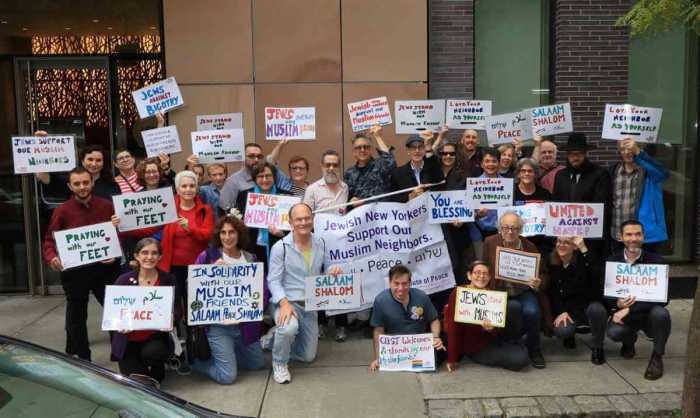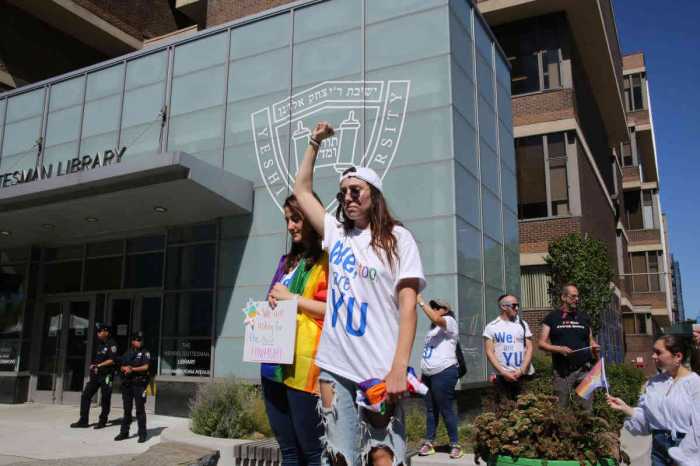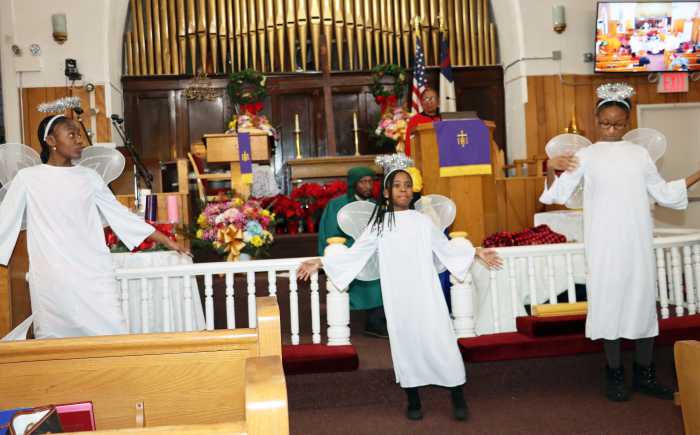Mayor Bill de Blasio on May 8, making the presentation of his final executive budget for the fiscal year beginning July 1. | ROB BENNETT/ OFFICE OF MAYOR BILL DE BLASIO
With the May 8 release of his final executive budget proposal for fiscal year 2015, Mayor Bill de Blasio is making good on his commitment from last year’s campaign to step up city support for homeless youth shelter space by 100 beds each year.
In a budget totaling $73.9 billion, the mayor is proposing to spend $15.96 million in the Runaway/ Homeless Youth (RHY) category, which provides city funding for shelter beds, for the fiscal year beginning July 1. That contrasts with spending of $12.34 million for the year that began July 1, 2012.
According to Carl Siciliano, the founding executive director of the Ali Forney Center, which provides housing and social services to homeless LGBT youth in the city, the current count of beds funded by the city stands at roughly 250, so the de Blasio commitment represents an increase of roughly 40 percent in the stock of available shelter space.
Mayor proposes to increase spending by more than $3 million, formalizes earlier pledge to cap AIDS housing rents
“This is unprecedented,” Siciliano said of the administration’s spending proposal. “The city has never stepped up with this sort of commitment.
The fact sheet issued by the administration in tandem with the mayor’s budget presentation highlighted the fact that of the 100 new beds, 24 will be targeted to serve LGBT youth, a population often at risk in general population homeless shelter settings.
Several years ago, Ali Forney, other non-profit groups serving homeless youth, and an array of LGBT organizations from the Empire State Pride Agenda to Congregation Beit Simchat Torah launched the Campaign for Youth Shelter, which called on the city and state to grow the supply of beds serving this population by 100 each year until waiting lists for available space disappear. The advocacy focused on that measure of growth rather than a target total number of beds, Siciliano explained, because it is difficult to pinpoint exactly what supply is needed to meet the needs of kids sleeping on the street or engaging in high-risk survival sex to get a roof over their heads.
A widely cited census of youth homelessness in New York City, carried out by the Empire State Coalition in 2007, estimated that on an average night 3,800 people 24 and younger find themselves on the street, with as many as 40 percent of that total identifying as LGBT or questioning. But homelessness can be episodic, so the total number of youth engaged in street life over the course of a year could total considerably higher than the 3,800.
According to Siciliano, the average bed can serve up to 10 youth during any given year, so 100 new beds could provide shelter for up to 1,000 youth without a place to sleep — and the increased stock of 350 beds, correspondingly, could serve a total of 3,500 youth.
How far the incremental increase in available beds goes in eliminating or reducing waiting lists at facilities serving youth will likely become clear only after the stock is up and running. The de Blasio administration, then, could find itself revisiting its campaign commitment a year from now as it develops its 2016 budget.
The mayor’s willingness to lead on the homeless youth issue contrasts sharply with an annual budget dance that took place during Michael Bloomberg’s years in office. His executive budgets repeatedly cut RHY funding, and it was left to City Council Youth Services Committee chair Lew Fidler and out lesbian Speaker Christine Quinn to battle to restore the baseline and grow it modestly.
And since Governor Andrew Cuomo took office in 2010, the state’s share of funding for beds in the city has also declined.
Even with those hurdles, advocates succeeded over the past half dozen years in winning an increase in the stock of beds from about 170 to the current 250.
During a March 2013 mayoral debate sponsored by the city’s LGBT political clubs at Baruch College, each of the Democratic candidates endorsed the Campaign for Youth Shelter’s proposal for growing city support for homeless beds. Siciliano said he was particularly impressed, at the time, by the responses he heard from Quinn and from de Blasio, who, he recalled, said the homelessness crisis facing queer youth was “the LGBT symbol of a tale of two cities.”
Late last month, Ali Forney and the National Coalition for the Homeless announced the launch of a National Campaign for Youth Shelter. That campaign, which will focus first on building grassroots support for putting the issue of youth homelessness on the nation’s political agenda in advance of the 2016 elections, has a long-term goal of adding 22,000 new beds across the US. The two groups estimate that, at present, there are only about 4,000 available beds to serve a population of as many as half a million young people who experience homelessness each year. The campaign has the support of roughly three-dozen groups nationwide, including those working in LGBT advocacy as well as others fighting homelessness and poverty.
The campaign plans a 6 p.m. rally on June 2 in New York’s Washington Square Park.
The mayor’s final executive budget reiterated the commitment made in his preliminary proposal issued February 12 to spend more than $17 million to cover two thirds of the cost of a program to cap the rents of New Yorkers living with AIDS and recieving housing assistance at 30 percent of their income. The state will cover the remaining cost of that cap, which has long been sought by advocates and will put AIDS housing assistance on par with rental assistance programs helping other eligible populations in New York.
Opposition to the rental cap by former Mayor Michael Bloomberg was the key hurdle that blocked past efforts in Albany to enact such relief, with cost sharing by the state and city, under New York law.
The mayor and the City Council have until June 30 to complete work on a final budget agreement.




































